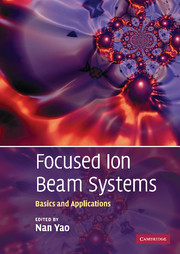Book contents
- Frontmatter
- Contents
- List of contributors
- Preface
- 1 Introduction to the focused ion beam system
- 2 Interaction of ions with matter
- 3 Gas assisted ion beam etching and deposition
- 4 Imaging using electrons and ion beams
- 5 Characterization methods using FIB/SEM DualBeam instrumentation
- 6 High-density FIB-SEM 3D nanotomography: with applications of real-time imaging during FIB milling
- 7 Fabrication of nanoscale structures using ion beams
- 8 Preparation for physico-chemical analysis
- 9 In-situ sample manipulation and imaging
- 10 Micro-machining and mask repair
- 11 Three-dimensional visualization of nanostructured materials using focused ion beam tomography
- 12 Ion beam implantation of surface layers
- 13 Applications for biological materials
- 14 Focused ion beam systems as a multifunctional tool for nanotechnology
- Index
- References
6 - High-density FIB-SEM 3D nanotomography: with applications of real-time imaging during FIB milling
Published online by Cambridge University Press: 12 January 2010
- Frontmatter
- Contents
- List of contributors
- Preface
- 1 Introduction to the focused ion beam system
- 2 Interaction of ions with matter
- 3 Gas assisted ion beam etching and deposition
- 4 Imaging using electrons and ion beams
- 5 Characterization methods using FIB/SEM DualBeam instrumentation
- 6 High-density FIB-SEM 3D nanotomography: with applications of real-time imaging during FIB milling
- 7 Fabrication of nanoscale structures using ion beams
- 8 Preparation for physico-chemical analysis
- 9 In-situ sample manipulation and imaging
- 10 Micro-machining and mask repair
- 11 Three-dimensional visualization of nanostructured materials using focused ion beam tomography
- 12 Ion beam implantation of surface layers
- 13 Applications for biological materials
- 14 Focused ion beam systems as a multifunctional tool for nanotechnology
- Index
- References
Summary
Introduction
The ability to acquire, display, and interrogate multi-dimensional volumetric data sets has been well established through various scientific disciplines. The medical field in particular has exposed the public to tomographic methods through now common medical procedures such as computed axial tomography (CAT), magnetic resonance imaging (MRI), and positron emission tomography (PET). In an analogous fashion the focused ion beam (FIB) and scanning electron microscope (SEM) can combine to generate tomographic data using the FIB-SEM platform.
Early work completed by a small number of researchers gives an indication of the variety of information that can be obtained by FIB based tomography: Uchick et al. [1] and Kotula et al. [2] have produced secondary electron (SE) and X-ray images (XEDS) of 3D structures; Dunn et al. [3] have created 3D mass spectral images using planar FIB etching (FIB-SIMS); Inkson et al. [4] and Sakamoto et al. [5] have published 3D reconstructions based on secondary electron images, and Principe [6] has demonstrated the application of FIB-Auger spectroscopic 3D reconstruction at 10 nm resolution. Konrad et al. [7] have demonstrated sequential automated acquisition of 3D electron backscatter pattern (EBSP) tomographic data. This prior work has shown that FIB based tomographic methods have volumetric data resolution down to 20 nm or less (i.e., FIB-SE, FIB-Auger) and have tremendous potential for a variety of investigations in both material science and biology.
- Type
- Chapter
- Information
- Focused Ion Beam SystemsBasics and Applications, pp. 146 - 186Publisher: Cambridge University PressPrint publication year: 2007
References
- 3
- Cited by



